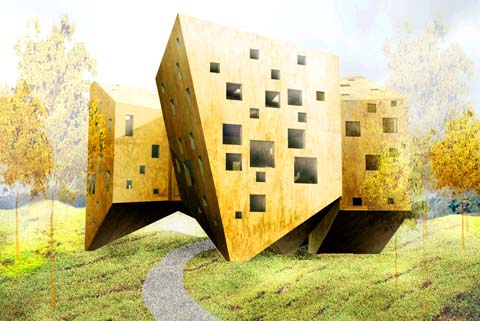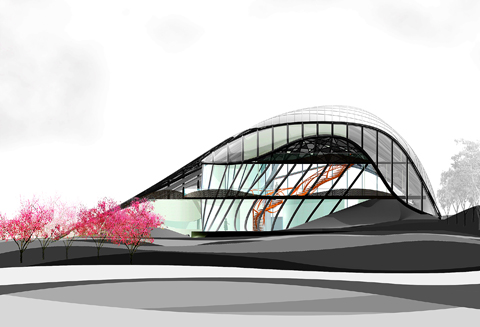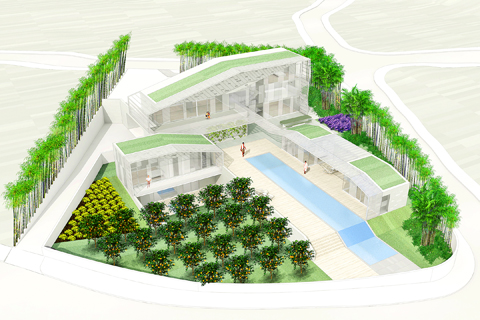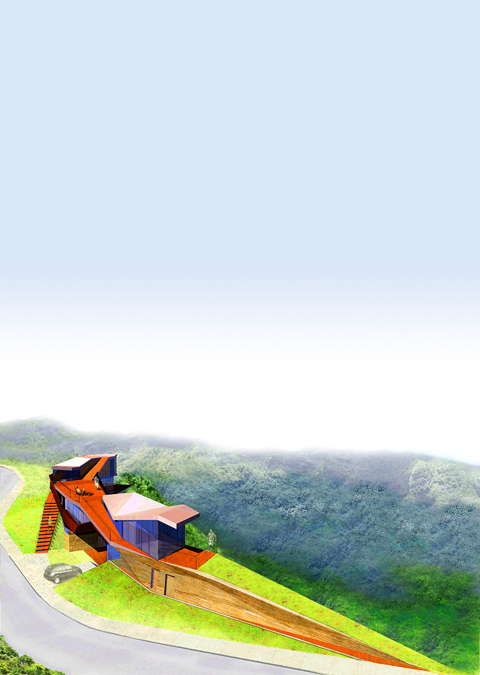A house whose structure was inspired by a Matisse painting, a dwelling that creates “architecture out of nature,” a residential compound that emphasizes a healthy lifestyle and the traditional Taiwanese family unit — these are just a few of the designs and themes explored by some of the world’s top architects for a project located in Taipei County’s Aodi (台北縣澳底), a fishing port on Taiwan’s northeast coast.
The project, called Next Gene20, is the work of 10 international and 10 Taiwanese architects who gathered at Taipei’s XueXue Institute (學學文創志業) last week to present their creations. Next Gene20 has already gained attention in the architecture and design world: the project has been invited to the prestigious La Biennale di Venezia, one of Europe’s top art fairs and one of the world’s most influential architecture exhibitions. The project’s houses are slated to begin construction next year and will be completed by 2010.
‘Next generation’ lifestyles

PHOTO COURTESY OF NEXT GENE20
“Just as you [in Taiwan] are proud of having the world’s tallest [occupied] building, you should also be proud of this project,” said Toshiko Mori, chair of the Department of Architecture at Harvard University’s Graduate School of Design, and one of the Next Gene20 architects, at the press conference.
One of the project’s main goals is to “explore the concept of ‘next generation’ lifestyles and the relationship between architecture and landscape,” said Liu Yu-tung (劉育東), Next Gene20’s head architect and vice-president of Asia University (亞洲大學) in Taichung County (台中縣).
“They’re strange buildings,” Liu said in a phone interview, since the houses don’t look like typical vacation homes. But they are cutting-edge, he said, for their “experimental” architecture, and as such, are aimed at affluent Taipei residents looking for a weekend getaway or second home. Many of the residences are eye-catching for their non-linear shapes, curved lines and glass walls.

PHOTO COURTESY OF NEXT GENE20
Liu, who holds a doctorate in design from Harvard, said he is proud of the outcome of the Next Gene20. The project’s A-list architects, who hail from the US, Europe, Japan, South Korea, China and Taiwan, have all “put in more effort than I could have ever imagined,” he said.
He added that the final product has turned out to be “theoretically strong,” which has attracted the interest of one of the industry’s major magazines, A+U (Architecture and Urbanism), which is devoting a full issue to the project.
Liu said Taiwanese architecture would benefit from Next Gene20. It has provided new “platforms” that raise the visibility of Taiwanese architects and connects them with an international network.

PHOTO COURTESY OF NEXT GENE20
Standing out
In the architecture world, the project is exceptional for what Liu called its “group creation” concept, in which the 20 architects formed an artistic “dialogue.” The group dynamic also inspired “positive competition” and heightened creativity among the architects, he said.
According to Liu, Next Gene20 also represents a “turning point” for architecture in Taiwan, which is advancing in two directions. The first is that the public and government sector in Taiwan have started to engage high-profile architects such as Toyo Ito of Japan, who designed the Taichung Metropolitan Opera House (台中大都會歌劇院). The second is more investment from private construction corporations, as in the case of Next Gene20, which was initiated by Lu Tai-nien (呂台年), chairman of the Genuine Group (捷年集團).

PHOTO COURTESY OF NEXT GENE20
Among Next Gene20’s notable works is Kung Shu-chang’s (龔書章) Radix House, which was inspired by Henri Matisse’s painting, Dance. The house looks like five giant, pointed stones standing together; like Matisse’s dancers, who each stand on one foot, the structure rests on the tip each “stone,” thus minimizing damage to the ground below. Kung’s house is also intended to foster an appreciation of the surroundings — the south side has large windows for viewing the forest. As for environmental considerations, the east and west sides of the house have small windows to shield it from wind in winter and sunlight in summer.
Blending in
Julien de Smedt’s Twirl House, on the other hand, literally blends into the landscape. Its structure is weaved into gently sloping hills — the roofs are shaped like arches with grass growing on top. His design took into consideration the constant changes in vegetation and soil due to typhoons to make his house “in symbiosis with the environment,” de Smedt said. The sides of the house are mostly window glass, but their placement is arranged so that it is easy to see out, but not in. “[The house] celebrates views and protects itself from being viewed,” de Smedt said at the press conference.
Despite the radical look, the Denmark-based architect says his team worked with “excellent local architects and consultants to make sure our house embodied Taiwanese values.” A resident of the house will feel “happy to live there,” de Smedt said later in an e-mail exchange.
Flexivilla is Toshiko Mori’s reaction to Taipei’s urban density: she designed a compound-like space with a grand feel, so both the building and its occupants have space to “breathe.” Three pavilions are connected by covered walkways, allowing for outdoor activities even in inclement weather. This multi-pavilion design suits the traditional Taiwanese family unit, where several generations often live together under one roof, while also allowing for individual privacy. By integrating indoor and outdoor spaces, Flexivilla promotes a “healthy lifestyle,” and an “ecological way of living,” Mori said.
Next Gene20’s works point to a future that takes greater consideration of the environment. In the past, a piece of architecture was merely “a figure with the landscape as the background,” Liu said. “This project reverses the relationship … we fit [our work] with land and nature and try to merge our architecture with the natural land,” he said.

Most heroes are remembered for the battles they fought. Taiwan’s Black Bat Squadron is remembered for flying into Chinese airspace 838 times between 1953 and 1967, and for the 148 men whose sacrifice bought the intelligence that kept Taiwan secure. Two-thirds of the squadron died carrying out missions most people wouldn’t learn about for another 40 years. The squadron lost 15 aircraft and 148 crew members over those 14 years, making it the deadliest unit in Taiwan’s military history by casualty rate. They flew at night, often at low altitudes, straight into some of the most heavily defended airspace in Asia.

Beijing’s ironic, abusive tantrums aimed at Japan since Japanese Prime Minister Sanae Takaichi publicly stated that a Taiwan contingency would be an existential crisis for Japan, have revealed for all the world to see that the People’s Republic of China (PRC) lusts after Okinawa. We all owe Takaichi a debt of thanks for getting the PRC to make that public. The PRC and its netizens, taking their cue from the Chinese Communist Party (CCP), are presenting Okinawa by mirroring the claims about Taiwan. Official PRC propaganda organs began to wax lyrical about Okinawa’s “unsettled status” beginning last month. A Global

Taiwan’s democracy is at risk. Be very alarmed. This is not a drill. The current constitutional crisis progressed slowly, then suddenly. Political tensions, partisan hostility and emotions are all running high right when cool heads and calm negotiation are most needed. Oxford defines brinkmanship as: “The art or practice of pursuing a dangerous policy to the limits of safety before stopping, especially in politics.” It says the term comes from a quote from a 1956 Cold War interview with then-American Secretary of State John Foster Dulles, when he said: ‘The ability to get to the verge without getting into the war is

Like much in the world today, theater has experienced major disruptions over the six years since COVID-19. The pandemic, the war in Ukraine and social media have created a new normal of geopolitical and information uncertainty, and the performing arts are not immune to these effects. “Ten years ago people wanted to come to the theater to engage with important issues, but now the Internet allows them to engage with those issues powerfully and immediately,” said Faith Tan, programming director of the Esplanade in Singapore, speaking last week in Japan. “One reaction to unpredictability has been a renewed emphasis on